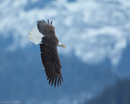Juneau, Haines, and the Chilkat Bald Eagle Preserve
page 2 of 5
Stephen Fischer Photography
Despite being at the northern end of the inside passage and just east of Glacier Bay, the Chilkat river and surrounding basin is uncharacteristically warm in comparison to much of the rest of southeast Alaska. This is due to the river being warmed as it permeates through a basin of alluvial fans as created by erosion from ancient glaciers that once cut through this valley. Average temperatures tended to be in the mid-20's farenheit during the days of my visit, which is warm by Alaskan standards for this time of year.
Much of the river is basin is fairly wide, more than a mile across in many areas of the lower stretch closer to Haines, creating some dramatic open views with towering mountains surrounding the area on three sides. At certain locations there are choke points where the river basin tightens and in addition runs close to the Haines highway, creating some ideal opportunities to get closer to the eagles that congregate along the river. In particular, between mile markers 19 and 20, an official set of parking areas exist for viewing and photographing the eagles in close proximity. One can continue on this highway, reaching the border with Canada in another 20 miles, but the visibility of eagles and convenient access to the Chilkat river diminishes. Much of the land this far north tends to be under the control of the local tribal council of the Alaskan Chilkat Tlingits indians who historically have fished these rivers for their sustenance. The Chilkat river is also famous for being the launching off point for the Klondike gold rush that occurred in the late 1800’s.
With respect to bald eagle photography, birds from the surrounding regions start arriving on the Chilkat river in larger numbers toward the end of October, peaking in mid-November, with the numbers starting to diminish as more and more as the river freezes up. During the peak period the eagles tend to be fairly fat and happy living off the salmon that more typically end up washing on shore by their own devices (i.e. dying after their spawning), or many times dragged to the banks by seagulls that also inhabit to this area. The bald eagle being much bigger and with razor sharp talons, will then come along and bully the salmon away from the seagull. They will then start eating the salmon right there on the gravel bar or the bank of the river while the seagull or gulls will stand nearby, stealing a bit every now and then. Typically a skirmish will occur as one eagle after another flies in on a diving run in an effort to drive off the previous claimant of the fish, with the next victor temporarily hording the salmon for themself. These attack runs can create some entertaining action sequences for photography or video. Sometime the party finishes prematurely after the salmon is sufficiently diminished in size, and an eagle decides it would be easier to take or steal of what remains of the fish and fly off to a tree to finish it up in relative peace.
<article continued on the next page>











